Abstract
This paper studies the problem of joint power allocation and user association in wireless heterogeneous networks (HetNets) with a deep reinforcement learning (DRL)-based approach. This is a challenging problem since the action space is hybrid, consisting of continuous actions (power allocation) and discrete actions (device association). Instead of quantizing the continuous space (i.e., possible values of powers) into a set of discrete alternatives and applying traditional deep reinforcement approaches such as deep Q learning, we propose working on the hybrid space directly by using the novel parameterized deep Q-network (P-DQN) to update the learning policy and maximize the average cumulative reward. Furthermore, we incorporate the constraints of limited wireless backhaul capacity and the quality-of-service (QoS) of each user equipment (UE) into the learning process. Simulation results show that the proposed P-DQN outperforms the traditional approaches, such as the DQN and distance-based association, in terms of energy efficiency while satisfying the QoS and backhaul capacity constraints. The improvement in the energy efficiency of the proposed P-DQN on average may reach 77.6% and 140.6% over the traditional DQN and distance-based association approaches, respectively, in a HetNet with three SBS and five UEs.
1. Introduction
With the exponential growth of wireless Internet-of-Things (IoT) sensors and ultra-reliable requirement in the next-generation cellular networks, the global mobile data traffic is expected to reach about 1 zettabyte by 2022 according to Cisco’s forecast [1]. To meet the demands of higher data traffic in wireless links either in fixed sensors for IoT networks or mobile devices in cellular networks, the network infrastructure inevitably will need to expand dramatically, which will result in tremendous escalation of energy consumption and backhaul traffic. Energy efficiency and spectral efficiency are therefore critical issues when designing next-generation wireless communication systems with enabling quality-of-service (QoS) guarantees for radio devices with considerations of efficient power consumption [2,3].
Enhancing the cell density is one of the approaches to meet the need of high date rate under limited bandwidth in centralized networks. Heterogeneous networks (HetNets) have therefore emerged as a standard part of future mobile networks to improve the system capacity and energy efficiency through more flexible design of transmission power allocation and smaller coverage sizes by densely deployed small base stations (SBSs) [3,4,5]. However, the interference problem caused from various SBSs is the primary challenge for effective system capacity improvement.
1.1. Motivation
Cell densification of HetNet enhances the spectrum efficiency in an energy-efficient way. On the other hand, cell densification potentially increases the inter-cell interference, especially at the cell edges, which deteriorates the QoS of user equipments (UEs). Interference coordination schemes by means of radio resource allocation and power control can be implemented to achieve higher energy efficiency and spectral efficiency [2]. However, the growing complexity of wireless networks due to increased links and heterogeneous network structure create tremendous challenges for system designs, thus calling for more intelligent techniques for effective yet efficient resource management strategies. In this perspective, data-driven machine learning techniques have been regarded as viable new approaches to dealing with complex network dynamics [5,6,7,8,9,10]. Compared with traditional model-based algorithms [11,12,13,14], deep reinforcement learning (DRL), leveraging recent advances in deep neural networks with reinforcement learning [15,16,17], can autonomously extract features from the raw data with different formats and complex correlations experienced by the mobile environments. This potentially reduces the cost of data pre-processing [11,18]. In view of this, in this paper, we provide a reinforcement-learning-based solution for power allocation and radio device association with the objective of maximizing energy efficiency while satisfying the required QoS and wireless backhaul capacity constraints.
1.2. Prior Work
In order to intelligently manage the interwoven dynamics underlying the wireless sensor or mobile networks in which a variety of network parameters are generally unknown, deep reinforcement learning (DRL)-based approaches have been applied to tackle the challenges of radio resource management in wireless networks, e.g., [11,16,18,19,20,21,22,23,24,25,26,27], due to DRL’s ability to extract features from raw data, learn complex correlations generated by the mobile environment, and make sequential decisions through interactions with the environment without knowledge of complete environment information. In the applications of power allocation, the objectives can often be categorized into three types: capacity maximization in [11,19,20], energy saving in [16], and maximization of capacity for consumed energy (which is defined as the energy efficiency) in [21,22,23,24].
Meng et al. [11] propose several DL-based algorithms to handle the power allocation with the aim to maximize the sum rate in multiuser wireless cellular networks, in which the DL-based data-driven approaches are demonstrated to outperform the traditional model-based power allocation method. Nasir and Guo [16] utilize multi-agent deep RL to adaptively control the discrete power level (i.e., the range of possible power values is quantized into a number of discrete levels) for each user where the policy can be made without requiring to know the instantaneous CSI. Park and Lim [18] tackle the problem of discrete power allocation and mode selection in device-to-device (D2D) communication networks using DQN with energy efficiency as the reward in the learning process. Amiri et al. [19] apply the cooperative Q-learning for power control at discrete levels, but the effect of channel variations is not considered. Ahmed and Hossain [20] employ deep Q-learning, which was originally proposed in [28], to update the transmission power allocated for each user at the small cell base station in HetNet, in which the power is quantized into discrete levels. Xu et al. [21] present a novel DRL-based technique for resource allocation by considering power efficiency in cloud radio access networks (RANs) and ensuring QoS guarantee. Lu et al. [22] propose a DRL-DPT framework, in which the agent learns directly from the expected objective instead of critic value, for energy efficiency maximization without explicit simulation results for QoS guarantee. Wei et al. determine the number of users and subchannels with corresponding power allocation in HetNets using a policy-gradient based actor–critic learning algorithm [23]. Instead of quantizing the power into discrete levels, Meng et al. [11] model the power as a continuous action and adaptively update the continuous power using the deep deterministic policy gradient-based (DDPG-based) reinforcement learning [29,30]. While the above-mentioned research successfully apply the DRL-based techniques to power allocation in heterogenous networks, the problem of user association is not jointly considered, and various practical constraints in the network are not accounted for, such as the limited backhaul capacity [13] in each small cell base station. A novel energy-efficient joint power allocation and user association using deep reinforcement learning is studied by Li et al. in [24], where the power is considered as belonging to a discrete set and the learning process is not bounded by any constraints. A summary of the related work is provided in Table 1.

Table 1.
Summary of Related Work in Power Allocation and User Association. A check mark “✓” means the issue in the column is considered in the corresponding reference, whereas a cross mark “×” means otherwise.
1.3. Contributions of the Research
In contrast with existing studies, which quantized the continuous set into discrete space [16,19,20], we propose utilizing the parameterized deep Q-network (P-DQN) to handle the problem with a hybrid action space composed of discrete user association and continuous power allocation [31]. This overcomes the difficulty of traditional DQN which can cope with RL problems having discrete action spaces, either with intrinsically discrete actions or with discrete actions quantized from continuous action space. In this work, we provide a joint solution for power allocation and user association with the objective of maximizing downlink energy efficiency under backhaul link constraint and QoS guarantee using P-DQN. A flexible reward function is devised to meet each user equipment’s QoS demands in different traffic scenarios, and a penalty mechanism is introduced when the backhaul link constraint is violated. Simulation results demonstrate that the P-DQN outperforms other approaches in terms of overall energy efficiency while satisfying QoS requirements and backhaul constraints. The main contributions of this paper are summarized as follows:
- We provide a joint solution for the power allocation and user association with the objective of maximizing downlink energy efficiency under backhaul link constraint and QoS guarantee. We employ the novel model-free parameterized deep Q-network (P-DQN) framework that is capable of updating policies in a hybrid discrete-continuous action space (i.e., discrete BS-UE association and continuous power allocation).
- To the best of our knowledge, most DRL-based research about power allocation do not consider the wireless backhaul capacity constraint and user QoS. We design the flexible reward function to meet the QoS demands at different traffic scenarios and introduce a penalty mechanism when the backhaul link constraint is violated. We verify by simulations that the proposed P-DQN framework outperforms other proposed approaches in terms of overall energy efficiency while satisfying QoS requirements and backhaul constraints.
1.4. Organization
The rest of the paper is organized as follows. The system model is described in Section 2. We next present the joint energy-efficiency maximization problem of clustering decision and power allocation in Section 3. Simulation results are given in Section 4. Finally, we provide concluding remarks in Section 5.
2. System Model
2.1. Heterogeneous Network
Consider the downlink of a two-tier HetNet composed of a macro base station (MBS), J small BSs (SBS), and K UEs, with and being the sets of SBSs and UEs, respectively. The system network is depicted in Figure 1. In this paper, we assume there is no cross-tier interference in the network, which can be achieved by using different frequency bands for transmissions in the two tiers (e.g., sub-6 GHz in tier 1 and millimeter wave bands in tier 2).
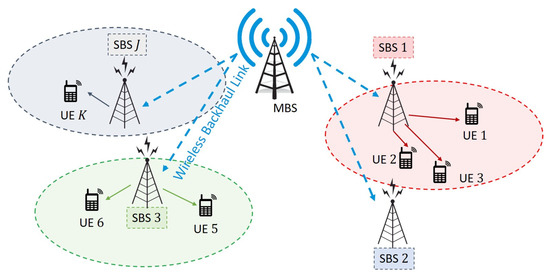
Figure 1.
An illustration of the considered wireless network. Each cluster consists of an SBS and its serving UEs.
The MBS is equipped with an antenna array of size , which is assumed to be larger than the the number of SBS J, i.e., and . Orthogonal frequency division multiple access (OFDMA) is utilized for the downlink communication between SBSs and UEs, with a total number of subchannels .
2.2. User Association
Each UE is assumed to be associated with only one SBS, but each SBS can serve multiple UEs using OFDMA. The UEs served by the same SBS constitute a cluster. Let denote the set of subchannels allocated to the kth UE and represent the status of user association, i.e., if the kth UE is associated with the jth SBS and otherwise. Then, the set of UEs in the cluster j is given by , with being the number of UEs in . The SBS serving the kth UE can be represented by Note that, since each user is assumed to be associated with only one SBS in this paper, equals one. The set of active SBSs is .
The spectral efficiency of the kth UE is given by
where the signal-to-noise-plus-noise ratio (SINR) is
with being the channel gain between the jth SBS and the kth UE in subchannel f, the interference observed by the kth UE, and the noise power. Specifically, the channel gain is defined as , where is the corresponding channel coefficient. The transmit power from SBS j to UE k in subchannel f needs to satisfy the power constraint , where is the maximum transmit power of the jth SBS. The user sum-rate for the jth cluster is given by
We consider the scenario that each SBS allocates orthogonal subchannels to different UEs within its serving coverage, so there is no intra-cluster interference in each cluster. Each UE can acquire at least one subchannel for data transmission if the cluster size (i.e., the number of served UEs) is not larger than the number of subchannels. Without intra-cluster interference, the interference term is composed only by the inter-cluster interference and can be expressed by
Detailed notation descriptions are summarized in Table 2.

Table 2.
Notation summary.
2.3. Power Consumption
The system power consumption includes the operational power, which is the minimum amount of power to keep the SBS active, and data transmission power. Operational powers for SBSs and MBS are expressed as and , respectively. The total power consumption of all SBSs is
where is the number of active SBSs.
3. Problem Formulation
3.1. Optimization Problem
We aim for a joint solution optimizing for the user association and transmit power allocation with the objective of maximizing energy efficiency, which is defined as the achievable sum rate per consumed power, in the downlink of the two-tier HetNet while considering QoS guarantee and wireless backhaul link capacity constraints. The problem can be formulated as
in (4b) assumes that each UE is served by only one SBS, and in (4c) refers to transmit power limit at the jth SBS with the maximum power available at the jth SBS. in (4d) indicates the QoS requirement for each UE, where is the capacity threshold for UE k. in (4e) is the cluster size constraint with the maximum allowable number of users in . This ensures that UEs in the same cluster are assigned different subchannels to avoid intra-cluster interference. in (4f) indicates the backhaul link capacity constraint, where is the maximum achievable downlink data rate for SBS j. Note that the subchannel assignment is assumed to be known and is not considered in this work.
The strategy in (4a) attempts to maximize the energy efficiency by finding the optimal user association and power allocation, which is generally a challenging problem with various unknowns and hybrid unknown spaces (continuous power and discrete clustering) in the system. Furthermore, the optimization problem in (4a) deals with a one-shot scenario at a certain time instant which needs to be re-evaluated when the network evolves to the next time instant. To tackle the challenges, we are therefore motivated to resort to the techniques of reinforcement learning (RL).
3.2. Reinforcement Learning
RL as one kind of machine learning is well known for its capability of making decisions sequentially in dynamic environments, where the decision-making agent interacts with the environments by an appropriately chosen action which is based on its past experiences learned through a reward function and on its current environment state the agent is experiencing [15]. These constitute the three fundamental elements in an RL: state (), action (), and reward (). Typically, an RL formulates the environment dynamics as a Markov decision process (MDP), and the primary objective is to determine the action contingent upon a certain state at each time step such that the expected discount cumulated reward is maximized. More specifically, traditional Q-learning aims at finding the action that maximizes the action-value function defined by
where is the discount factor.
It is a challenging task to evaluate the Q-function in (5) in many applications, since the statistical properties between any two states are often not easy to obtain. Fortunately, thanks to the advancement in deep neural networks (DNNs), evaluations of the Q-function in (5) can be well approximated by properly designed DNNs [28]. Specifically, during the training phase, the weights in the deep Q learning (DQN) network are trained to extract features from raw data with corresponding target values obtained by the recursive Bellman equation developed from (5). The success of DQN has led to an explosive subsequent development in the area of deep reinforcement learning (DRL), such as the more stabilized version of the DQN (double DQN in [32]), the extension to continuous actions using the deep deterministic policy gradient (DDPG) in [29], and the TD3 [33].
3.3. State, Action, and Reward function
In this research, the state, action, and reward function associated with the penalty mechanism for the wireless backhaul capacity constraint in the considered RL-based joint power allocation and user association are defined as follows:
- State: The state at the time slot is defined as the user data rate in that time slot
- Action: The action in the time slot is defined aswhere , with and indicating the sets of user associations and power allocations, respectively. More specifically, the power allocation set is given by , where is the vector of allocated power for data transmission in all subchannels assigned to UE k from its associated SBS .
- Reward: We aim to maximize the overall energy efficiency as in (4a) while maintaining QoS for each US and satisfying the backhaul link capacity constraint for each SBS. Hence, the reward at the time slot is defined aswherewith being the system energy efficiency andbeing the penalty term which discourages the agent from taking the actions such that the capacity of each user deviates too much from the QoS threshold, and and are the Z-scores (i.e., standardized results) of and , respectively. is a threshold used to reduce the likelihood of violating the backhaul capacity constraint.
One of the challenges when transforming a traditional optimization problem into a DRL problem is to devise proper handling of the constraints in the original optimization problem. In this paper, the penalty term in is designed to improve the QoS satisfaction in constraint through reducing the number of UEs whose achievable rates are much higher or lower than the capacity thresholds. The weights control the significance of the corresponding term. Operators can tune the weights and according to their needs, e.g., setting at off-peak traffic periods and at peak traffic hours to enhance each user’s service experiences. Note that the reward function defined in (8) may not be feasible in practice, and judicious setting for the associate weights and are needed based on trial-and-error efforts. Furthermore, in order to guide the agent to follow the backhaul link constraint, a penalty mechanism is introduced here for the agent to adjust corresponding actions. If one of the SBSs experiences a sum rate that violates the backhaul capacity constraint, the agent receives a penalty and restarts a new episode in the learning process. On the other hand, in this paper, the cluster size constraint is dealt with by including only the legitimate discrete actions, each of which allows no more than users in each cluster, in the constrained discrete action space for the entire learning process. This guarantees the output of the discrete action satisfies the cluster size constraint. Finally, in order to accommodate the power constraint in , techniques mentioned in the above can also be utilized. Alternatively, in this work, modifications have been made to the power constraint such that each user’s allocated power is restricted by , where the per-user maximum power is assumed to be for . In this case, the total power constraint in can be satisfied, though in a suboptimum fashion. This per user power constraint can be facilitated by the actor-parameter network in the proposed P-DQN in a much easier way.
3.4. Parameterized Deep Q Network
Recent progress in deep RL (DRL) approaches has made the DRL, such as DQN, a viable technique to tackle various resource allocation problems in wireless networks. However, in order for DQN to be able to solve the joint power allocation and user association problem considered in this work, the continuous action space in the power allocation has to be quantized into discrete action space first. Quantization of the continuous action space may round off potentially optimal power allocations. Moreover, the complexity of the DQN increases exponentially with the dimension of the action space, leading to undesirable huge consumption of power and slowdown of convergence speed. To overcome this difficulty, in this paper, we propose employing the P-DQN [31,34] for the joint power allocation and user association because of its capability of solving problems with hybrid action space.
The parameterized action space is denoted by by , where and are the continuous and discrete action spaces, respectively. When the discrete action c takes all possible combinations into consideration without constraints, the discrete action space . Each discrete action c has a corresponding continuous parameter , where is the set of all users’ power allocations in this work, for a discrete action c. The primary network of the P-DQN (without the stabilizing target networks) is presented in Figure 2. The primary network in Figure 2 consists of an actor-parameter network with weights , which maps the state c and each discrete action to its corresponding continuous parameter, and an actor network with weights , which evaluates the action-value Q-function, i.e., the long term expected cumulative reward defined in (5), and the action can be explicitly represented by the 2-tuple to emphasize the hybrid nature in the action. Typically, the weights in the actor-parameter network can be determined by maximizing the expected action-value function . Furthermore, the weights in the actor network can be updated by minimizing the mean-squared error , where is the target value in the network and [28,31].
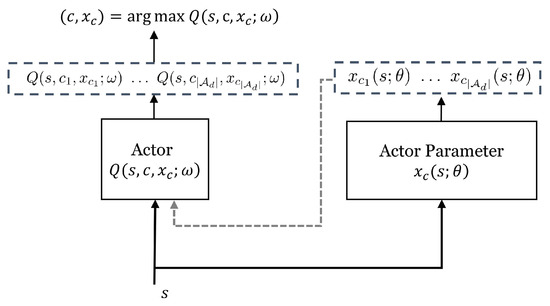
Figure 2.
Illustration of the primary network in P-DQN. At each time slot, the actor-parameter decides the continuous parameter based on the current state s. Then actor takes the action according to the current state s and the continuous parameter .
In order to stabilize the P-DQN, an additional target network, combining the original primary network shown in Figure 2, is built to produce the target value needed in the actor network [28]. Furthermore, to expedite the training process, an experience replay buffer is implemented to provide random samples for evaluating the means appearing in the loss functions of both the actor network and actor-parameter network. With the replay buffer, the loss functions for the actor-parameter and the actor can be obtained by the following sample means:
where is evaluated by the target network for stability with weights and , is sampled from the replay buffer, and N is the size of the mini-batch (i.e., sample size). The weights and are updated according to
where and are the learning rate for the weights in the actor-parameter and actor network, respectively.
At a given state s, the actor-parameter network produces the continuous parameters, which maximize the average for each discrete action c. Then, the actor network determines the action after the action-value Q-function has been evaluated with the aid of the target network. In the training phase, the off-policy scheme is implemented where the agent selects the action based on -greedy policy and generates the Q-target using the greedy policy for exploration. The algorithm of the proposed P-DQN with the target networks is summarized in Algorithm 1.
| Algorithm 1 Parameterized Deep Q-Network (P-DQN) Algorithm with the quasi-static target networks. |
|
4. Simulation Results
4.1. Simulation Setup
In the simulation, a HetNet with three SBSs and five UEs uniformly located in a macrocell with radius 500 m is considered. Backhaul transmission model considered in [35] is adopted in the simulations. The MBS is equipped with 100 antennas and has 20 beamforming groups [35]. Slow Rayleigh fading channels are adopted for simulations where the channel remains unchanged throughout each episode. The Rayleigh channel coefficient is modeled as (0,1). We also adopt the non-line-of-sight path-loss model for urban MBSs and SBSs [36]. Each subchannel is randomly allocated to a user, and the subchannel allocation is assumed known for the agent. The other settings of the simulation are summarized in Table 3. The Adam optimizer is employed for all DNNs that are embedded in P-DQN. The -greedy algorithm and Ornstein-Uhlenbeck noise is used for explorations of discrete actions and continuous parameters, respectively. We set the threshold , discount factor , batch size , the maximum number of episodes as 2000, and the maximum steps per episode as 100. Other parameter settings used in the P-DQN are given in Table 4. The simulation codes used in this research can be found in [37].

Table 3.
Simulation Parameters.

Table 4.
The settings for the deep neural networks used in the P-DQN.
4.2. Performance Analysis
In the simulations, we compare the proposed P-DQN for joint user clustering and power allocation with the following approaches:
- Nearest SBS + Random Power: Each UE is associated with the nearest SBS. Random power means that each SBS serves the UEs in its cluster with random powers in a way that the resulting sum rate within the cluster cannot exceed the power and backhaul capacity limit.
- Best Channel + Random Power: Each UE is associated with the SBS with the best received signal power, which depends on the UE-SBS distance as well as the small-scale fading effect. Furthermore, each SBS serves the UEs in its cluster with random power allocations under the power and backhaul capacity constraint.
- P-DQN Association + Random Power: The user association policy is accomplished by the proposed P-DQN, whereas each SBS serves the UEs in its cluster with random powers under the total power and backhaul capacity constraint.
- Random Association + P-DQN Power: Each SBS allocates the power to its serving UEs based on the policy determined by the P-DQN. Each UE is randomly associated with one SBS in such a way that the random association policy obeys the backhaul link constraint.
- DQN with Five Discrete Power Levels: The continuous power space is quantized into L non-uniform power intervals, with L discrete power levels with . In this simulation, L is set to 4.
We set the weights for both the P-DQN with the cluster size constraint and the P-DQN without the cluster size constraint, which allows us to observe the effect of the cluster size constraint in . Figure 3 depicts the average normalized reward versus steps over 500 realizations during the training phase. It shows the convergence of the user association and power allocation algorithm using the proposed P-DQN. Note that, while the P-DQN approach without cluster size constraint provides higher reward as can be seen from Figure 3, it cannot guarantee all UEs’ QoS. Figure 4 shows the effectiveness of the proposed P-DQN algorithm, as it outperforms other approaches in terms of both the reward and the energy efficiency. The numerical values of the reward and energy efficiency obtained in Figure 4 and averaged over all time steps are summarized in Table 5. The improvement in the energy efficiency of the proposed P-DQN on average may reach 77.6% over the traditional DQN and 140.6% over the nearest-distance-based association approaches.
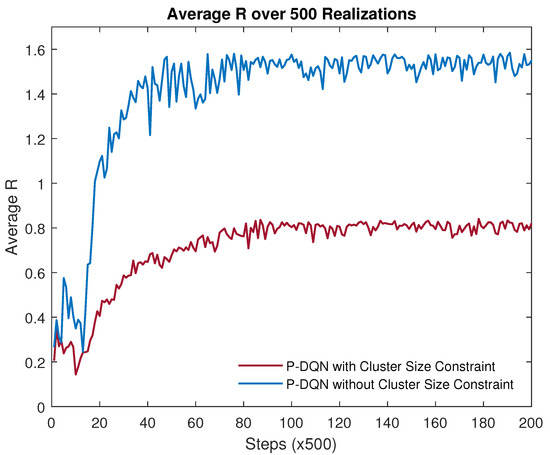
Figure 3.
Convergence property of the proposed P-DQN algorithm.
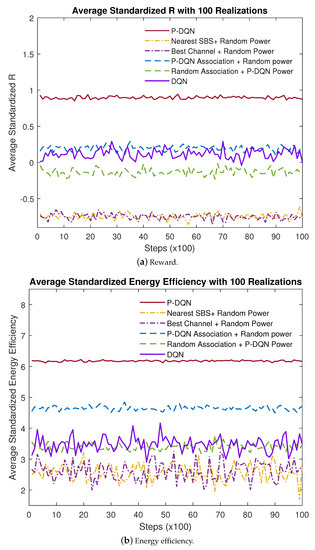
Figure 4.
Performance of the proposed reward function. (a) Reward. (b) Energy efficiency.

Table 5.
The average standardized value of the reward and the energy efficiency, obtained from the results in Figure 4 and averaged over all time steps. The method index in the table is: (A) P-DQN with Cluster Size Constraint, (B) Nearest SBS + Random Power, (C) Best Channel + Random Power, (D) P-DQN Association + Random Power, (E) Random Association + P-DQN Power, and (F) DQN with Cluster Size Constraint.
Figure 6c, the P-DQN without the cluster size constraint tends to have all UEs served only by one SBS in the pursuit of small-system power consumption (as large operational power is consumed by any active SBS).
Table 6 shows that each UE obtains 83.47% of the required QoS, and each SBS obeys the wireless backhaul capacity constraint at each timeslot through the proposed P-DQN with the cluster size constraint. However, the percentage of QoS satisfaction for the methods with random power or random association is about 50%. The percentage of QoS satisfaction of the proposed P-DQN with the cluster size constraint is higher than that of the other approaches, as a penalty term is used in the reward function to realize each UE’s QoS as much as possible in the proposed P-DQN. For Random Association + P-DQN Association, the ratio is even smaller than 5%. For DQN with cluster size constraint, the ratio is even smaller than 1%, as the quantized power levels suffer from round-off imperfections, while the continuous action learned by the P-DQN allows for a better QoS with appropriate continuous power allocation.

Table 6.
The percentage of wireless backhaul link constraint satisfaction and QoS satisfaction. The method index in the table is as follows: (A) P-DQN with Cluster Size Constraint, (B) Nearest SBS + Random Power, (C) Best Channel + Random Power, (D) P-DQN Association + Random Power, (E) Random Association + P-DQN Power, and (F) DQN with Cluster Size Constraint.
In Figure 5, we analyze the interference power experienced by each UE under various approaches. The results in Figure 5a,c,e demonstrate that the interference each user experiences in the “Nearest SBS + Random Power” approach is higher than that in the “P-DQN with Cluster Size Constraint” approach and “P-DQN Association + Random Power” approach. By comparing the results in Figure 5a,e, it can be seen that random power allocation does not have much impact on each user’s received interference level. On the other hand, by comparing the results in Figure 5c,e, we observe a noticeably increased interference level in UE 3 and UE 4, which implies that the interference is largely dominated by the result of user association. The results here indicate that the user association policy learned by the proposed P-DQN with cluster size constraint generally tends to determine the matching between UEs and SBSs such that the inter-cluster interference can be managed to a lower level, as shown in Figure 5a, which results in a higher system throughput.
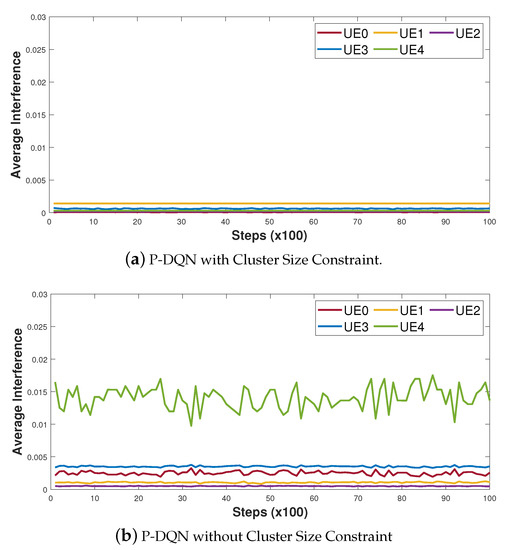
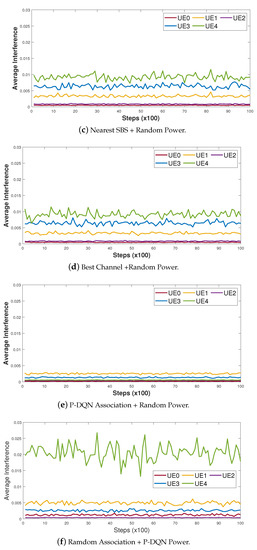
Figure 5.
Average interference level of all power allocation and user association approaches. P-DQN association and P-DQN power refer to those of “P-DQN with Cluster Size Constraint”.
The increased level of interference in UEs (such as UE 3 and UE 4) observed in Figure 5c can be explained with the aid of Figure 6, which plots the locations of each UE and SBS with their association status being specified by colors. The association results and physical distances between each user and all SBSs in Figure 6 can provide insights into the interference level each UE experiences under different association strategies. For example, the increased interference in UE 4 in Figure 5c can be analyzed by comparing Figure 6b with Figure 6a. More specifically, while UE 4 in Figure 6a associated with SBS 2 under the proposed P-DQN with cluster size constraint is interfered only by inter-cluster signals transmitted from SBS 1, this UE 4 associated with SBS 2 in Figure 6b under the “Nearest SBS” (i.e., nearest distance) association approach can potentially be interfered with by inter-cluster signals from SBS 0 and SBS 1. It can be seen from Figure 6b that SBS 0 could strongly interfere with UE 4, due to the short distance between SBS 0 and UE 4, thus leading to the increased interference level in UE 4 as shown in Figure 6b. Finally, as for the case of P-DQN approach without cluster size constraint, the system suffers from intra-cluster interference, which significantly impacts the interference level in each user as shown in Figure 5b. Since keeping an SBS active demands huge operational power, we can see from Figure 6c that the P-DQN without a cluster size constraint tends to have all UEs served only by one SBS in pursuit of less overall system power consumption.
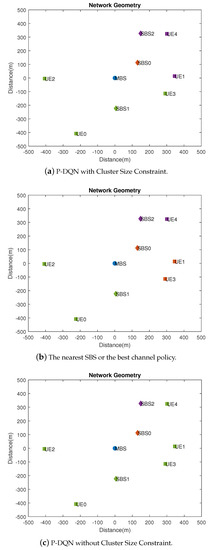
Figure 6.
The results of user association. (a) P-DQN with cluster size constraint. (b) The nearest SBS policy. (c) P-DQN without cluster size constraint. Each SBS and its associated UEs are shown in the same color.
In contrast with the user association schemes based on the distance or the channel quality between a UE and an SBS, the P-DQN-based user association tends to activate fewer SBSs, which leads to less consumption of overall operational power in the SBSs and results in a higher energy efficiency. More specifically, as illustrated in Figure 6a, where different colors refers to different clusters, we see thatUE 0, UE 2 and UE 3 are associated with SBS 1, and UE 1 and UE 4 are connected to SBS 2, whereas SBS 0 is not active when employing the policy learned by P-DQN with the cluster size constraint.
5. Conclusions
In this paper, we have studied the joint problem of user association and power allocation using P-DQN in the downlink of a two-tier HetNet without knowledge of the environment transition probability. The wireless network has been formulated as a parameterized action Markov decision process with a hybrid (discrete-continuous) action space. The P-DQN has been adopted as a model-free framework to avoid quantization noise resulting from rounding the continuous power space into discrete levels. With the consideration of realistic scenarios, we have designed the reward function as the energy efficiency with QoS constraint per user as well as backhaul capacity constraint. We have introduced a penalty mechanism when the constraints are violated. We have also utilized the cluster size constraint for intra-cluster interference mitigation. In simulations, the proposed P-DQN has been verified to outperform other traditional methods in terms of overall energy efficiency while satisfying QoS requirements and backhaul constraints. The improvement in the energy efficiency of the proposed P-DQN on average may reach 77.6% over the traditional DQN, both with the cluster size constraint. Meanwhile, the proposed P-DQN may still suffer from the curse of dimensionality when dealing with problems with sizable action spaces. It will be worthwhile to investigate advanced DRL techniques (such as the DDPG technique or the multi-agent RL), in future work, capable of handling the problems of joint user association and power allocation, which typically have large action spaces in scenarios of practical interest.
Author Contributions
Conceptualization, F.-T.C.; Investigation, C.-K.H. and F.-T.C.; Methodology, C.-K.H. and F.-T.C.; Resources, F.-T.C.; Writing—original draft, C.-K.H. and K.-L.C.; Software, C.-K.H. and K.-L.C.; Funding acquisition, F.-T.C.; Writing—review and editing, F.-T.C. All authors have read and agreed to the published version of the manuscript.
Funding
This research was funded by the Ministry of Science and Technology (MOST) in Taiwan under grant number MOST 109-2221-E-009-101.
Institutional Review Board Statement
Not applicable.
Conflicts of Interest
The authors declare no conflict of interest.
References
- Cisco. Cisco visual networking index: Global mobile data trafc forecast update, 2017–2022 white paper. Update 2019. [Google Scholar]
- Hu, R.Q.; Qian, Y. An energy efficient and spectrum efficient wireless heterogeneous network framework for 5G systems. IEEE Commun. Mag. 2014, 52, 94–101. [Google Scholar] [CrossRef]
- Mili, M.R.; Hamdi, K.A.; Marvasti, F.; Bennis, M. Joint optimization for optimal power allocation in OFDMA femtocell networks. IEEE Commun. Lett. 2016, 20, 133–136. [Google Scholar] [CrossRef]
- Sambo, Y.A.; Shakir, M.Z.; Qaraqe, K.A.; Serpedin, E.; Imran, M.A. Expanding cellular coverage via cell-edge deployment in heterogeneous networks: Spectral efficiency and backhaul power consumption perspectives. IEEE Commun. Mag. 2014, 52, 140–149. [Google Scholar] [CrossRef]
- Amiri, R.; Almasi, M.A.; Andrews, J.G.; Mehrpouyan, H. Reinforcement learning for self organization and power control of two tier heterogeneous networks. IEEE Trans. Wirel. Commun. 2019, 18, 3933–3947. [Google Scholar] [CrossRef]
- Jiang, C.; Zhang, H.; Ren, Y.; Han, Z.; Chen, K.C.; Hanzo, L. Machine learning paradigms for next-generation wireless networks. IEEE Trans. Wirel. Commun. 2017, 24, 98–105. [Google Scholar] [CrossRef]
- Zhang, C.; Patras, P.; Haddadi, H. Deep learning in mobile and wireless networking: A survey. IEEE Commun. Surv. Tutor. 2019, 21, 2224–2287. [Google Scholar] [CrossRef]
- Deng, D.; Li, X.; Zhao, M.; Rabie, K.M.; Rupak, K. Deep learning-based secure MIMO communications with imperfect CSI for heterogeneous networks. Sensors 2020, 20, 1730. [Google Scholar] [CrossRef] [PubMed]
- Liu, S.; He, J.; Wu, J. Dynamic cooperative spectrum sensing based on deep multi-user reinforcement learning. Appl. Sci. 2021, 11, 1884. [Google Scholar] [CrossRef]
- Munaye, Y.Y.; Juang, R.T.; Lin, H.P.; Tarekegn, G.B.; Lin, D.B. Deep Reinforcement Learning Based Resource Management in UAV-Assisted IoT Networks. Appl. Sci. 2021, 11, 2163. [Google Scholar] [CrossRef]
- Meng, F.; Chen, P.; Wu, L.; Cheng, J. Power allocation in multi-user cellular networks: Deep reinforcement learning approaches. IEEE Trans. Wirel. Commun. 2020, 19, 6255–6267. [Google Scholar] [CrossRef]
- Tam, H.H.M.; Tuan, H.D.; Ngo, D.T.; Duong, T.Q.; Poor, H.V. Joint load balancing and interference management for small-cell heterogeneous networks with limited backhaul capacity. IEEE Trans. Wirel. Commun. 2016, 16, 872–884. [Google Scholar] [CrossRef]
- Ma, H.; Zhang, H.; Wang, X.; Cheng, J. Backhaul-aware user association and resource allocation for massive mimo-enabled HetNets. IEEE Commun. Lett. 2017, 21, 2710–2713. [Google Scholar] [CrossRef]
- Zhang, H.; Huang, S.; Jiang, C.; Long, K.; Leung, V.C.M.; Poor, H.V. Energy efficient user association and power allocation in millimeter-wave-based ultra dense networks with energy harvesting base stations. IEEE J. Select. Areas Commun. 2017, 35, 1936–1947. [Google Scholar] [CrossRef]
- Sutton, R.S.; Barto, A.G. Reinforcement Learning: An Introduction; MIT Press: Cambridge, MA, USA, 2018. [Google Scholar]
- Nasir, Y.S.; Guo, D. Multi-agent deep reinforcement learning for dynamic power allocation in wireless networks. IEEE J. Select. Areas Commun. 2019, 37, 2239–2250. [Google Scholar] [CrossRef]
- He, C.; Hu, Y.; Chen, Y. Joint power allocation and channel assignment for NOMA with deep reinforcement learning. IEEE J. Select. Areas Commun. 2019, 37, 2200–2210. [Google Scholar] [CrossRef]
- Park, H.; Lim, Y. Reinforcement learning for energy optimization with 5G communications in vehicular social networks. Sensors 2020, 20, 2361. [Google Scholar] [CrossRef]
- Amiri, R.; Mehrpouyan, H.; Fridman, L.; Mallik, R.K.; Nallanathan, A.; Matolak, D. A machine learning approach for power allocation in HetNets considering QoS. In Proceedings of the 2018 IEEE International Conference on Communications (ICC), Kansas City, MO, USA, 20–24 May 2018; pp. 1–7. [Google Scholar]
- Ahmed, K.I.; Hossain, E. A deep Q-learning method for downlink power allocation in multi-cell networks. arXiv 2019, arXiv:1904.13032. [Google Scholar]
- Xu, Z.; Wang, Y.; Tang, J.; Wang, J.; Gursoy, M.C. A deep reinforcement learning based framework for power-efficient resource allocation in cloud RANs. In Proceedings of the 2017 IEEE International Conference on Communications (ICC), Paris, France, 21–25 May 2017; pp. 1–6. [Google Scholar]
- Lu, Y.; Lu, H.; Cao, L.; Wu, F.; Zhu, D. Learning deterministic policy with target for power control in wireless networks. In Proceedings of the 2018 IEEE Global Communications Conference (GLOBECOM), Abu Dhabi, United Arab Emirates, 9–13 December 2018; pp. 1–7. [Google Scholar]
- Wei, Y.; Yu, F.R.; Song, M.; Han, Z. User scheduling and resource allocation in HetNets with hybrid energy supply: An actor-critic reinforcement learning approach. IEEE Trans. Wirel. Commun. 2018, 17, 680–692. [Google Scholar] [CrossRef]
- Li, D.; Zhang, H.; Long, K.; Wei, H.; Dong, J.; Nallanathan, A. User association and power allocation based on Q-learning in ultra dense heterogeneous networks. In Proceedings of the 2019 IEEE Global Communications Conference (GLOBECOM), Waikoloa, HI, USA, 9–13 December 2019; pp. 1–7. [Google Scholar]
- Liberati, F.; Giuseppi, A.; Pietrabissa, A.; Suraci, V.; Giorgio, A.D.; Trubian, M.; Dietrich, D.; Papadimitriou, P.; Priscoli, F.D. Stochastic and exact methods for service mapping ualized network infrastructures. Int. J. Netw. Manag. 2017, 27, 872–884. [Google Scholar] [CrossRef]
- Gao, J.; Zhong, C.; Chen, X.; Lin, H.; Zhang, Z. Deep Reinforcement Learning for Joint Beamwidth and Power Optimization in mmWave Systems. IEEE Commun. Lett. 2020, 24, 2201–2205. [Google Scholar] [CrossRef]
- Zhang, L.; Tan, J.; Liang, Y.C.; Feng, G.; Niyato, D. Deep Reinforcement Learning-Based Modulation and Coding Scheme Selection in Cognitive Heterogeneous Networks. IEEE Trans. Wirel. Commun. 2019, 18, 3281–3294. [Google Scholar] [CrossRef]
- Mnih, V.; Kavukcuoglu, K.; Silver, D.; Graves, A.; Antonoglou, I.; Wierstra, D.; Riedmiller, M. Playing atari with deep reinforcement learning. arXiv 2013, arXiv:1312.5602. [Google Scholar]
- Lillicrap, T.P.; Hunt, J.J.; Pritzel, A.; Heess, N.; Erez, T.; Tassa, Y.; Silver, D.; Wierstra, D. Continuous control with deep reinforcement learning. arXiv 2015, arXiv:1509.02971. [Google Scholar]
- Silver, D.; Lever, G.; Heess, N.; Degris, T.; Wierstra, D.; Riedmiller, M. Deterministic policy gradient algorithms. In Proceedings of the 31st ICML, Beijing, China, 21–26 June 2014; pp. 387–395. [Google Scholar]
- Hausknecht, M.; Stone, P. Deep reinforcement learning in parameterized action space. arXiv 2015, arXiv:1511.04143. [Google Scholar]
- Van Hasselt, H.; Guez, A.; Silver, D. Deep reinforcement learning with double q-learning. In Proceedings of the 30th AAAI Conference on Artificial Intelligence, Phoenix, AZ, USA, 12–17 February 2016. [Google Scholar]
- Fujimoto, S.; Hoof, H.; Meger, D. Addressing function approximation error in actor-critic methods. In Proceedings of the International Conference on Machine Learning, New York, NY, USA, 19–24 June 2016. [Google Scholar]
- Xiong, J.; Wang, Q.; Yang, Z.; Sun, P.; Han, L.; Zheng, Y.; Fu, H.; Zhang, T.; Liu, J.; Liu, H. Parametrized deep q-networks learning: Reinforcement learning with discrete-continuous hybrid action space. arXiv 2018, arXiv:1810.06394. [Google Scholar]
- Wang, N.; Hossain, E.; Bhargava, V.K. Joint downlink cell association and bandwidth allocation for wireless backhauling in two-tier HetNets with large-scale antenna arrays. IEEE Trans. Wirel. Commun. 2016, 15, 3251–3268. [Google Scholar] [CrossRef]
- 3rd Generation Partnership Project (3GPP). Further Advancements for E-UTRA Physical Layer Aspects (Release 9); 3rd Generation Partnership Project (3GPP): Sofia Technology Park, France, 2016. [Google Scholar]
- Simulator. Available online: https://github.com/chikaihsieh/ Power-Allocation-and-User-Device-Association-with-Deep-Reinforcement-Learning/tree/main (accessed on 27 April 2021).
Publisher’s Note: MDPI stays neutral with regard to jurisdictional claims in published maps and institutional affiliations. |
© 2021 by the authors. Licensee MDPI, Basel, Switzerland. This article is an open access article distributed under the terms and conditions of the Creative Commons Attribution (CC BY) license (https://creativecommons.org/licenses/by/4.0/).